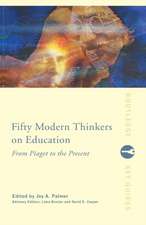Higher Education: Patterns of Change in the 1970s: Routledge Library Editions: Education
Editat de John Lawloren Limba Engleză Hardback – 8 dec 2011
Din seria Routledge Library Editions: Education
-
 Preț: 379.49 lei
Preț: 379.49 lei -
 Preț: 400.94 lei
Preț: 400.94 lei -
 Preț: 377.16 lei
Preț: 377.16 lei -
 Preț: 379.32 lei
Preț: 379.32 lei -
 Preț: 401.34 lei
Preț: 401.34 lei - 8%
 Preț: 382.25 lei
Preț: 382.25 lei - 18%
 Preț: 1332.87 lei
Preț: 1332.87 lei - 34%
 Preț: 819.90 lei
Preț: 819.90 lei - 27%
 Preț: 247.40 lei
Preț: 247.40 lei - 36%
 Preț: 819.90 lei
Preț: 819.90 lei - 36%
 Preț: 819.90 lei
Preț: 819.90 lei - 36%
 Preț: 819.90 lei
Preț: 819.90 lei - 36%
 Preț: 991.00 lei
Preț: 991.00 lei - 36%
 Preț: 822.76 lei
Preț: 822.76 lei - 36%
 Preț: 821.53 lei
Preț: 821.53 lei - 29%
 Preț: 259.98 lei
Preț: 259.98 lei - 36%
 Preț: 819.90 lei
Preț: 819.90 lei - 36%
 Preț: 761.85 lei
Preț: 761.85 lei - 36%
 Preț: 986.91 lei
Preț: 986.91 lei - 55%
 Preț: 541.50 lei
Preț: 541.50 lei - 36%
 Preț: 762.01 lei
Preț: 762.01 lei - 27%
 Preț: 261.37 lei
Preț: 261.37 lei - 36%
 Preț: 764.20 lei
Preț: 764.20 lei - 36%
 Preț: 762.97 lei
Preț: 762.97 lei - 36%
 Preț: 819.90 lei
Preț: 819.90 lei - 36%
 Preț: 986.91 lei
Preț: 986.91 lei - 36%
 Preț: 821.53 lei
Preț: 821.53 lei - 36%
 Preț: 819.90 lei
Preț: 819.90 lei - 36%
 Preț: 819.90 lei
Preț: 819.90 lei - 36%
 Preț: 821.13 lei
Preț: 821.13 lei - 38%
 Preț: 2100.27 lei
Preț: 2100.27 lei - 36%
 Preț: 819.90 lei
Preț: 819.90 lei - 36%
 Preț: 819.90 lei
Preț: 819.90 lei - 36%
 Preț: 764.20 lei
Preț: 764.20 lei - 36%
 Preț: 819.90 lei
Preț: 819.90 lei - 36%
 Preț: 986.91 lei
Preț: 986.91 lei - 36%
 Preț: 764.20 lei
Preț: 764.20 lei - 36%
 Preț: 819.90 lei
Preț: 819.90 lei - 36%
 Preț: 4048.76 lei
Preț: 4048.76 lei - 36%
 Preț: 736.38 lei
Preț: 736.38 lei - 36%
 Preț: 819.90 lei
Preț: 819.90 lei - 36%
 Preț: 821.53 lei
Preț: 821.53 lei - 36%
 Preț: 819.90 lei
Preț: 819.90 lei - 36%
 Preț: 819.90 lei
Preț: 819.90 lei - 36%
 Preț: 819.90 lei
Preț: 819.90 lei - 36%
 Preț: 819.90 lei
Preț: 819.90 lei - 36%
 Preț: 819.90 lei
Preț: 819.90 lei
Preț: 764.20 lei
Preț vechi: 1154.59 lei
-34% Nou
Puncte Express: 1146
Preț estimativ în valută:
146.25€ • 158.80$ • 122.85£
146.25€ • 158.80$ • 122.85£
Carte tipărită la comandă
Livrare economică 22 aprilie-06 mai
Preluare comenzi: 021 569.72.76
Specificații
ISBN-13: 9780415689205
ISBN-10: 0415689201
Pagini: 172
Dimensiuni: 156 x 234 mm
Greutate: 0.45 kg
Ediția:1
Editura: Taylor & Francis
Colecția Routledge
Seria Routledge Library Editions: Education
Locul publicării:Oxford, United Kingdom
ISBN-10: 0415689201
Pagini: 172
Dimensiuni: 156 x 234 mm
Greutate: 0.45 kg
Ediția:1
Editura: Taylor & Francis
Colecția Routledge
Seria Routledge Library Editions: Education
Locul publicării:Oxford, United Kingdom
Public țintă
General, Postgraduate, Professional, and UndergraduateCuprins
Preface. 1 In Lieu of Delphi: what? W H G Armytage. 2 The Futures of the Colleges of Education Stanley Hewett 3 The New Polytechnics: Their Principles and Potential Patrick Nuttgens 4 The Open University and the Problem of Inter-Disciplinary Education Arnold Kettle 5 The Structure of a Morally Committed University A B Pippard 6 Holes in the Walls: University Adult Education H A Jones 7 Rediscovering Identity in Higher Education W A C Stewart 8 Education for Life William Walsh. Appendix The Use and Interpretation of Student-Staff Ratios F J Orton. Index.
Descriere
This volume focuses on the changing pattern of tertiary education in the UK and the emphasis of the contributions is on the challenges and opportunities rather than the problems and difficulties of educationists at this level. The contributors are all leading figures in the educational world, and they are concerned in particular with the need for a partnership in the definition of aims and capabilities in higher education, in order to meet future needs. The potential of the (new) polytechnics and the use and interpretation of student/staff ratios, and the difficulties of interdisciplinary education are discussed.













